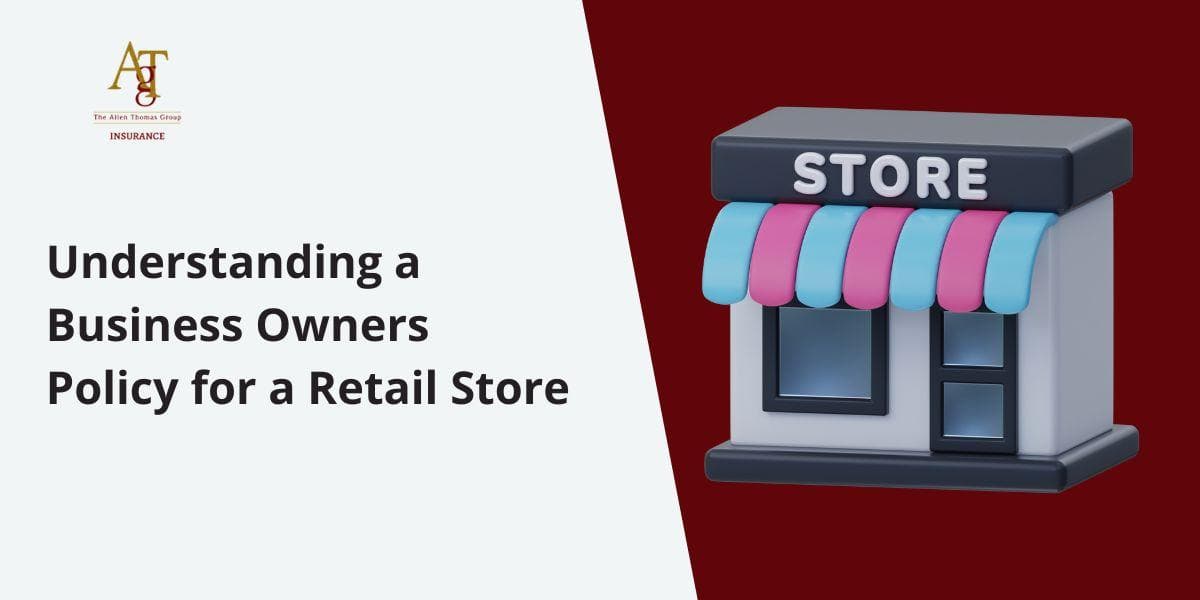A Business Owners Policy (BOP) provides a safety net that could keep your store up and running, even in the face of disaster.
From inventory theft to customer injuries, this all-in-one policy is designed to cover the risks specific to retail businesses.
This comprehensive guide will explain BOPs for retail stores, offering you a roadmap to securing your business against the unexpected.
Understanding Business Owners Policies
Running a retail store comes with its fair share of risks and uncertainties.
From customer injuries to property damage or even lawsuits, it’s crucial for retail business owners to protect themselves against potential financial losses.
One comprehensive retail insurance option that provides coverage for these common incidents is a Business Owners Policy (BOP).
A BOP is designed specifically for small to medium-sized businesses and combines several essential coverages into one policy, making it convenient and cost-effective. By bundling general liability insurance with commercial property insurance, a BOP offers comprehensive protection tailored to the unique needs of retail stores.
With a BOP, retail store owners can have peace of mind knowing that they are covered in various situations. For example, if a customer were to slip and fall inside the store and sustain an injury, the general liability coverage included in a BOP would help cover medical expenses and any potential legal claims that might arise from the incident.
Additionally, if there were any damage to the store’s inventory or equipment due to events like fire, theft, or vandalism, the commercial property coverage within the BOP would come into play.
It’s important to note that while a BOP provides robust coverage for common incidents faced by retail stores, it may not include all coverage options needed depending on the specific nature of your business.
For instance, if you offer professional services or operate vehicles as part of your retail business operations, additional policies such as professional liability insurance and commercial auto insurance may be necessary to ensure comprehensive coverage.
Hence, before purchasing a BOP, it’s recommended to assess your unique risk profile to determine if any additional policies are required alongside the standard BOP coverage.
A thorough evaluation of your business needs will help ensure that you have adequate protection against various risks.
Now that we understand the importance of a Business Owners Policy for retail stores, let’s explore the essential components that make up a typical BOP.
Essential Components of a BOP
A BOP is an all-encompassing insurance policy customized for retail businesses, but what are its essential components?
Let’s take a closer look at each of these key coverage options:
General Liability Insurance: This component of a BOP provides financial protection in the event of third-party claims involving bodily injury or property damage. For example, if a customer slips and falls in your store, resulting in injuries, general liability insurance would cover medical expenses and legal costs associated with any resulting lawsuits.
Commercial Property Insurance: This coverage protects your retail store’s building as well as the contents within it. It provides reimbursement for repair or replacement costs in the event of damage or destruction caused by covered perils such as fire, theft, vandalism, or natural disasters.
Business Interruption Insurance: In case of unforeseen circumstances like a fire or natural disaster that forces your retail store to temporarily close its doors, business interruption insurance helps cover ongoing expenses (rent, payroll) and lost profits during the period of closure.
Equipment Breakdown Coverage: This coverage protects against the cost of repairing or replacing equipment necessary for your retail operations if it breaks down due to mechanical or electrical failure. It can include items such as cash registers, refrigeration units, or computer systems.
Product Liability Insurance: If your retail store sells products, this component provides protection against claims arising from bodily injury or property damage caused by defective products you sell. It covers legal fees and potential settlements or judgments.
By having these essential components within a BOP, retail store owners can be confident in their ability to manage risks and protect their assets. While the inclusion of these components might differ slightly from one insurer to another, it’s crucial to review and understand the specific terms and conditions of your BOP policy to ensure comprehensive coverage for your retail business.
Possible Claims Covered by a BOP
As a retail store owner, anticipating potential risks and protecting your business against them is crucial. Luckily, a Business Owners Policy (BOP) offers comprehensive coverage that addresses various types of claims that retail stores commonly face.
One common claim covered by a BOP is property damage. This includes damages to the physical structure of your store caused by fire, weather events, vandalism, or other covered perils. Additionally, it may cover the loss or damage of your inventory, equipment, signs, and other physical assets essential for running your business.
Another important coverage area is business interruption. In the event of a covered property damage claim that leads to the temporary closure of your retail store, business interruption coverage can provide financial assistance by compensating for lost income during the closure period. It can help cover ongoing expenses such as rent or lease payments, employee wages, taxes, and loan payments.
For instance, imagine a severe storm damages the roof of your retail store, necessitating its closure for repairs. During this time, with business interruption coverage in place, you would receive compensation for the revenue lost due to the closure and continue to meet your financial obligations.
Liability claims also pose significant risks to retail store owners. A BOP typically includes general liability coverage, which protects you from third-party claims alleging bodily injury or property damage caused by your business’s operations. This coverage extends to accidents that occur on your premises or as a result of products you sell.
In addition to general liability coverage, another type of liability protection relevant to retail stores is product liability coverage. This coverage specifically addresses claims related to injuries or property damage resulting from products you sell.
For example, if a customer purchases a defective product from your store and gets injured while using it, product liability coverage can help protect you from legal and financial repercussions.
Lastly, retail stores often face the risk of cyberattacks and data breaches. With the increasing reliance on digital systems, protecting customer information is critical. A BOP may offer data breach coverage, which can help cover expenses associated with notifying affected customers, investigating the breach, providing credit monitoring services, and potential legal liabilities.
Understanding the wide range of claims covered by a BOP provides retail store owners with peace of mind in knowing they have comprehensive protection against the risks unique to their industry.
Coverage Options Relevant for Retail Stores

When it comes to coverage options tailored specifically for retail stores, a Business Owners Policy (BOP) offers various solutions that help address the specific risks and challenges faced by this sector.
One vital coverage option is commercial property insurance. As a retail store owner, your physical location and its contents are crucial to your business’s success. Commercial property insurance provides protection for your building, equipment, inventory, furniture, and fixtures in case of damage or loss caused by perils such as fire, theft, vandalism, or natural disasters.
Furthermore, crime insurance is another coverage option essential for retail store owners. This coverage safeguards your business against financial losses resulting from crimes like theft, robbery, burglary, employee dishonesty, or fraud. It can help compensate you for the cost of stolen merchandise or money and cover any repairs or replacements needed after criminal activities.
In addition to property-related coverage options, business liability insurance plays a significant role in protecting retail store owners. This includes general liability coverage that safeguards your business against third-party claims alleging bodily injury or property damage occurring on your premises or as a result of your products. It also often encompasses product liability coverage specifically designed for retail stores.
Lastly, many retail stores operate through an online platform or engage in digital transactions. As such, cyber liability insurance becomes crucial to protect against the risks associated with cyberattacks, data breaches, and other cybercrimes. This coverage helps cover the costs of notifying affected customers, investigating the breach, and managing legal liabilities that may arise from compromised customer data.
By considering these coverage options relevant to retail stores within a BOP, you can ensure comprehensive protection for your business against a wide range of risks and focus on providing excellent products and services to your customers.
Property and Liability Coverage
When it comes to running a retail store, protecting your property and safeguarding against liability risks is crucial. Property and liability coverage under a Business Owners Policy (BOP) play a vital role in ensuring comprehensive protection for your retail store.
First, let’s discuss property coverage. This aspect of a BOP protects your physical assets, such as the building itself, inventory, fixtures, equipment, and signage, from various perils like fire, theft, vandalism, or natural disasters. For example, if a fire were to break out in your store, property coverage would help cover the cost of repairs or replacements for damaged items.
It’s important to note that property coverage typically has certain limits and exclusions. Limits determine the maximum amount an insurance policy will pay for a covered loss. Exclusions are specific situations or perils that are not covered by the policy. Understanding these limitations can help you assess whether additional coverage options are necessary to fill any gaps in protection.
Now, let’s turn our attention to liability coverage. This component of a BOP provides financial protection in case your retail store is held responsible for bodily injury or property damage caused to others.
For instance, if a customer slips and falls inside your store due to a wet floor, liability coverage would help cover medical expenses or legal costs if they decide to sue.
Liability coverage not only includes bodily injury and property damage but also extends to personal and advertising injury liabilities. Personal injury refers to non-physical harm caused by actions like defamation or copyright infringement. Advertising injury relates to claims arising from misleading advertising practices.
Having sufficient liability coverage is essential for protecting your retail store against expensive lawsuits and potential financial ruin. It’s worth noting that different BOP policies might offer varying levels of liability coverage, so it’s crucial to carefully review the terms and limits provided by each policy.
Understanding the intricacies of property and liability coverage in a BOP can help you make informed decisions about the level of protection your retail store needs. By customizing your policy to adequately cover your physical assets and liability risks, you can mitigate potential financial losses and ensure the continuity of your business.
Now that we have explored property and liability coverage, let’s delve into another important aspect of a Business Owners Policy for retail stores: worker’s compensation and cyber liability.
Worker’s Compensation and Cyber Liability
Worker’s compensation insurance is designed to provide benefits for employees who suffer work-related injuries or illnesses.
For a retail store, there are various risks employees are exposed to daily, such as slips and falls, repetitive strain injuries, or even accidents while operating heavy machinery.
Having worker’s compensation coverage helps protect both your employees and your business by providing medical benefits, disability income, rehabilitation services, and legal representation in case of any work-related incidents.
In today’s digital age, cyber liability coverage has become increasingly important for businesses across all industries, including retail.
As a retailer handling sensitive customer information like credit card details or personal data, you are at risk of cyber threats such as data breaches, ransomware attacks, or identity theft.
Cyber liability insurance can assist with the costs associated with responding to a cyber incident, including legal fees, notification expenses, credit monitoring services for affected individuals, and even potential financial losses resulting from the breach.
It’s important to evaluate the specific risks your retail store faces when considering worker’s compensation and cyber liability coverage. Every business is unique in terms of its workforce composition and susceptibility to cyber threats. Working with an experienced insurance provider can help ensure you have adequate coverage tailored to your store’s specific needs.
For instance, consider a retail store that operates exclusively online. In this case, the risk of cyberattacks might be higher compared to a brick-and-mortar store with minimal online presence. Therefore, prioritizing cyber liability coverage in such a scenario is crucial to protect against potential financial losses and reputational damage.
By comprising worker’s compensation and cyber liability coverage in your Business Owners Policy, you can effectively address important aspects of employee well-being and protect your business from the ever-growing cyber risks prevalent in today’s digital landscape.
Selecting the Right BOP for Your Retail Store
Choosing the right Business Owners Policy (BOP) for your retail store is crucial to ensure comprehensive coverage that adequately protects your business. With numerous insurance options available, it can be overwhelming to navigate through the different policy offerings and determine the best fit.
However, by considering key factors specific to your retail store’s operations, you can make an informed decision.
Firstly, assess the size and nature of your retail store. Are you a small boutique or a large departmental store?
Evaluate the physical space, inventory, equipment, and potential risks associated with your business. This analysis will help determine the appropriate coverage amounts for property damage, general liability, and other specific needs your retail store may have.
Next, consider the specific risks prevalent in the retail industry.
A BOP should provide protection against common incidents like customer injuries, property damage, faulty products, and advertising injuries.
Retailers often face unique challenges such as slip-and-fall accidents or lawsuits related to product defects. Ensuring that these aspects are covered under your policy is essential for safeguarding your business.
Additionally, review any legal requirements or contractual obligations that may dictate certain coverage limits for your retail store.
For instance, if you lease a commercial space, your landlord might require specific liability insurance coverage to protect both parties in case of accidents or property damage. By understanding these requirements, you can choose a BOP that meets not just legal obligations but also addresses potential risks and liabilities faced by your business.
Engaging with a knowledgeable insurance agent from The Allen Thomas Group who has experience working with retailers can be immensely beneficial.
They can guide you through the process, explain policy details tailored to your needs, and answer any questions you may have about different coverage options.
Remember that selecting the right BOP for your retail store is an investment in protecting your business from unforeseen events and potential financial loss.
Taking the time to evaluate your unique circumstances and seeking professional guidance will help ensure that you have the coverage necessary to mitigate risks effectively.
Advantages of a Customized BOP for Retailers
Opting for a customized BOP tailored specifically for retailers offers several advantages compared to generic insurance policies. These advantages allow retail store owners to address their specific needs and risks in a more comprehensive and cost-effective manner.
Firstly, a customized BOP accounts for the unique risks associated with the retail industry.
Unlike generalized policies, which may overlook specific challenges faced by retailers, a customized BOP can include coverage for risks such as customer injuries, property damage, theft, or lawsuits related to products sold. By addressing these particular risks upfront, retail store owners have peace of mind knowing that their policy is designed to protect them against industry-specific hazards.
Furthermore, a customized BOP allows for flexibility in selecting coverage limits and deductibles based on individual business requirements.
By working closely with an experienced insurance agent who understands the nuances of the retail industry, you can create a customized BOP that provides maximum value for your investment while minimizing potential gaps in coverage.
Frequently Asked Questions
What is a business owners policy for retail?
A business owners policy (BOP) for retail is an insurance package that combines different types of coverage such as general liability, property damage, and loss of income, into one policy designed to protect a retail business from financial losses.
What types of coverage does a BOP include?
A business owners policy typically includes general liability, property damage, and loss of income coverage.
How much does a BOP cost?
The cost of a business owners policy depends on the type and amount of coverage needed as well as other factors such as the size and location of the business.
Are there any additional coverages I can add to my BOP?
Yes, depending on the needs of your specific business you may be able to add additional coverages such as professional liability, cyber liability, or equipment breakdown coverage to your BOP.
How do I choose an insurance provider for my BOP?
When choosing an insurance provider for your BOP it is important to research multiple providers to compare their offerings and ensure they are reputable and have experience working with businesses in your industry or similar industries.
Get A Free Retail Quote With The Allen Thomas Group
Are you ready to safeguard your retail store with a business owner’s policy?
The Allen Thomas Group’s insurance and financial professionals have over 20 years of experience with risk management solutions for retail stores.
Complete ATG’s easy online quote form today. Once we help you find the right policy, you can begin coverage quickly.
Get A Retail Store Insurance Quote Now
Author
